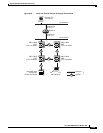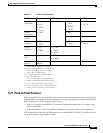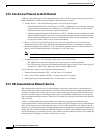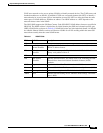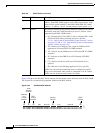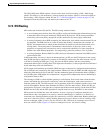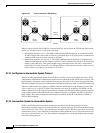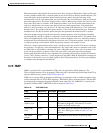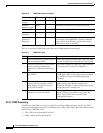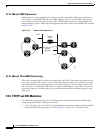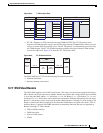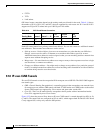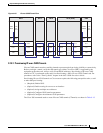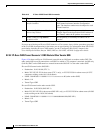
9-33
Cisco ONS 15600 Reference Manual, R7.2
Chapter 9 Management Network Connectivity
9.7.5 TARP
OSI routing begins when the ESs discover the nearest IS by listening to ISH packets. When an ES wants
to send a packet to another ES, it sends the packet to one of the ISs on its directly attached network. The
router then looks up the destination address and forwards the packet along the best route. If the
destination ES is on the same subnetwork, the local IS knows this from listening to ESHs and forwards
the packet appropriately. The IS also might provide a redirect (RD) message back to the source to tell it
that a more direct route is available. If the destination address is an ES on another subnetwork in the
same area, the IS knows the correct route and forwards the packet appropriately. If the destination
address is an ES in another area, the Level 1 IS sends the packet to the nearest Level 2 IS. Forwarding
through Level 2 ISs continues until the packet reaches a Level 2 IS in the destination area. Within the
destination area, the ISs forward the packet along the best path until the destination ES is reached.
Link-state update messages help ISs learn about the network topology. Each IS generates an update
specifying the ESs and ISs to which it is connected, as well as the associated metrics. The update is then
sent to all neighboring ISs, which forward (flood) it to their neighbors, and so on. (Sequence numbers
terminate the flood and distinguish old updates from new ones.) Using these updates, each IS can build
a complete topology of the network. When the topology changes, new updates are sent.
IS-IS uses a single required default metric with a maximum path value of 1024. The metric is arbitrary
and typically is assigned by a network administrator. Any single link can have a maximum value of 64,
and path links are calculated by summing link values. Maximum metric values were set at these levels
to provide the granularity to support various link types while at the same time ensuring that the
shortest-path algorithm used for route computation is reasonably efficient. Three optional IS-IS metrics
(costs)—delay, expense, and error—are not supported by the ONS 15600. IS-IS maintains a mapping of
the metrics to the quality of service (QoS) option in the CLNP packet header. IS-IS uses the mappings
to compute routes through the internetwork.
9.7.5 TARP
TARP is used when TL1 target identifiers (TIDs) must be translated to NSAP addresses. The
TID-to-NSAP translation occurs by mapping TIDs to the NETs, then deriving NSAPs from the NETs by
using the NSAP selector values (Table 9-9 on page 9-29).
TARP uses a selective PDU propagation methodology in conjunction with a distributed database (that
resides within the NEs) of TID-to-NET mappings. TARP allows NEs to translate between TID and NET
by automatically exchanging mapping information with other NEs. The TARP PDU is carried by the
standard CLNP Data PDU. TARP PDU fields are shown in Table 9-10.
Table 9-10 TARP PDU Fields
Field Abbreviation Size (bytes) Description
TARP Lifetime tar-lif 2 The TARP time-to-live in hops.
TARP Sequence
Number
tar-seq 2 The TARP sequence number used for loop detection.
Protocol
Address Type
tar-pro 1 Used to identify the type of protocol address that the
TID must be mapped to. The value FE is used to
identify the CLNP address type.
TARP Type
Code
tar-tcd 1 The TARP Type Code identifies the TARP type of
PDU. Five TARP types, shown in Table 9-11, are
defined.
TID Target
Length
tar-tln 1 The number of octets that are in the tar-ttg field.



